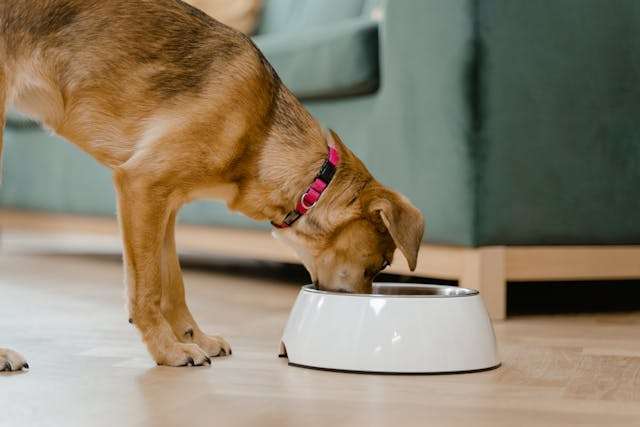The Healthiest Dog Food for Small Breeds You Haven’t Tried Yet [2025 Update]
The Healthiest Dog Food for Small Breeds You Haven’t Tried Yet [2025 Update]. Small breed dogs like Savannah need more than just any bag of dog food.
Their tiny bodies burn energy fast, so it’s crucial to pick the healthiest dog food for small breeds if you want them to thrive. Most brands focus on all sizes, but trying foods made just for small dogs can make a real difference.
Your food choice shapes more than a shiny coat, it also supports energy, focus, and even good behavior. The right nutrition helps with dog obedience training as well as long-term health.
After learning from Savannah’s experience, I know how helpful it is to look past the big popular names and explore lesser-known but high-quality options.
For those who want to learn more about the unique needs of different dog breeds, check out these Akita Dog Interesting Facts. Smart choices with food now mean a happier, healthier pup for years to come.
Key Takeaways
If you care about your small dog’s long-term health and want to see real change, what you feed them is as important as daily walks or fun playtime.
After working through Savannah’s own ups and downs with various foods, I’ve noticed clear patterns that might help other owners. Here are the lessons I’ve learned—use these tips to guide your search for the healthiest dog food for small breeds.
 Photo by MART PRODUCTION
Photo by MART PRODUCTION
Nutrition Needs Are Different for Small Breeds
Small-breed dogs, like Savannah, need more calories per pound than larger dogs. Their fast-burning metabolism means even a little nutrient imbalance shows quickly. It’s not just about feeding less food—it’s about packing more quality into smaller meals.
- Higher calorie density: Keeps up with their energy.
- Smaller kibble size: Makes chewing and digestion easier.
- Targeted nutrients: Supports healthy joints, shiny fur, and steady moods.
Don’t Just Trust the Big Brands
Many dog food shelves are filled with popular names, but the healthiest dog food for small breeds isn’t always from the most advertised brands.
I discovered that lesser-known companies often excel at quality and use better protein sources. For example, checking out detailed best small breed dog foods reviews can open the door to new choices you might not see at your local store.
Personalization Matters
Each dog is different—even among the same breed. What works for Savannah might not be the perfect fit for your pup. Keep an eye on your dog’s energy, coat, weight, and digestion as you switch foods.
- Watch for skin or stomach issues after a food change.
- Adjust the feeding plan if your dog is gaining or losing too easily.
- Choose food with meat or fish as the main ingredient.
If you’re curious about other breeds and their dietary quirks, K9Nutripick offers an in-depth comparison of Belgian Malinois vs German Shepherds—that’s a good read if you want context beyond just small breeds.
Training and Food Go Hand in Hand
Nutrition does more than fuel the body—it also shapes learning and behavior. Quality food often leads to better focus during dog obedience training.
I saw this with Savannah: switching foods led to calmer behaviors and faster learning in our sessions.
- Healthy fats and protein can help your dog stay more attentive.
- Treats used for dog trainig are most effective when made from wholesome ingredients.
- A well-fed pup has more patience and learns commands faster.
If you want to dive deeper into structured online support, there are resources on SpiritDog’s online dog training courses that work hand-in-hand with proper nutrition planning.
Reviews and Research Do Matter
Don’t skip the homework. I learned the value of analyzing unbiased dog food reviews instead of only trusting marketing claims.
Community discussions and third-party highlights, such as those found on r/DogAdvice discussions about small breed dog food, often reveal real-world experiences and red flags you won’t find in advertising.
If you want specialized recommendations for your small dog’s diet—including ideas for picky eaters and transitioning foods—K9Nutripick’s best dog food for British Bulldog puppies is a great companion guide for breed-specific advice.
These takeaways are the core of what I’ve learned from researching, testing, and seeing Savannah thrive. Use them as a foundation, and you’ll make smarter choices on your own journey for the healthiest dog food for small breeds.
Why Small Breeds Need Specialized Dog Food
Choosing The Healthiest Dog Food for Small Breeds is not just about finding a bag that says “small breed” on the label. Small dogs like Savannah have different needs than big breeds, right down to how they eat and the way they burn calories.
These differences mean a food that helps a Labrador thrive won’t fit a Pomeranian or Yorkie. By paying attention to these unique needs, we help our pups avoid common health problems and keep them happy for years.
Calorie and Nutrient Density for Small Dogs
Small breed dogs run at high speed, at least when it comes to energy use. Pound for pound, they burn more calories than larger breeds, which puts extra pressure on every meal to count.
For Savannah, I noticed she gets tired and moody if her food isn’t packed with energy and nutrients. That’s because of a much faster metabolism.
Dog foods for small breeds are made to solve this. They focus on:
- Higher calorie density: More energy in every bite helps meet fast-burning needs.
- Enriched nutrients: Essential vitamins, minerals, and antioxidants for lifters energy and healthier immune systems.
- Balanced protein and fat: Supports joints, shiny fur, and lean muscle in a compact package.
To make this easier, top brands for small dogs use formulas designed for these special requirements. If you look at something like the Best Dog Food for Small Breeds, you’ll notice that nutrient density is a big focus.
Quality brands will highlight how their food gives small dogs more nutrients in a smaller portion.
Savannah’s energy soared when I switched to a recipe with chicken and pumpkin, which aligns with what you find in limited ingredient diets for small bites. When every spoonful is rich in good stuff, small dogs don’t need to eat more to feel great; they just need to eat smarter.
Kibble Size and Texture: More Than Convenience
 Photo by MART PRODUCTION
Photo by MART PRODUCTION
Tiny jaws and little mouths can turn mealtime into a struggle if the kibble is too large or too hard. Small breeds like Savannah have narrower jaws and closer-set teeth—meaning the wrong kibble can lead to two big problems: tough chewing and poor dental health.
Why does kibble shape and size matter?
- Better oral hygiene: Specialized kibble scrapes away plaque as your dog chews, which protects those petite teeth.
- Comfortable eating: Small, crunchier pieces are easier for little mouths to grab and break down.
- Less choking risk: Appropriately sized food fits naturally in the mouth, making every mealtime smoother and safer.
Savannah used to struggle to eat larger kibbles and sometimes even gave up partway through her meal. Once I switched to smaller pieces, her appetite improved, and her teeth stayed healthier at vet checkups.
Many top-reviewed foods, like Small Breeds Dry Dog Food, feature bite-sized pieces made just for little dogs.
Check dog food reviews before you buy, as these can flag if a brand’s “small breed” recipe still uses chunky kibble.
If you want more guidance on finding formulas with small, easy-to-chew pieces, take a look at K9Nutripick’s resources on nutritional tips for Goldendoodles and other breed-specific advice.
Getting the details right—from calorie balance to kibble size—can have a real impact on your dog’s day-to-day quality of life, making mealtime a pleasure and boosting results in both health and dog obedience training. Small changes in your choice can make the biggest difference for your furry friend.
Underrated Yet Healthy Dog Food Options for Small Breeds
It’s easy to stick with popular kibble, but some of the healthiest options for small breeds fly under the radar. After feeding Savannah various brands, I found that novel proteins and whole food recipes can often bring big health gains for allergy-prone pups.
Small breed nutrition gets a real boost from high-quality ingredients, and knowing how to spot those foods (and see through the reviews) matters just as much as portion control.
Novel Proteins and Whole Food Ingredients
 Photo by Sam Lion
Photo by Sam Lion
Trying new protein sources isn’t just a trend—it can be a true solution if your small dog has itchy skin, hot spots, or frequent upset stomachs.
Switching up the main protein from chicken or beef to less common choices, like duck, venison, or even rabbit, cuts down on the risk of triggering food sensitivities. Savannah responded particularly well when I swapped out her standard kibble for a duck-based recipe.
Whole food ingredients give your dog real nutrition from whole cuts of meat, sweet potatoes, or veggies, not just fillers or flavor dust.
You’ll often notice a shinier coat, plus more energy for training and play. The best part? Foods with these ingredients deliver better results for dog obedience training and overall focus. They also often feature fewer chemicals and preservatives that can drag down health.
Some key benefits of choosing these formulas:
- Reduced allergy risk: Less typical proteins mean fewer triggers for sensitive dogs.
- Better digestibility: Whole food recipes are easier on tiny stomachs.
- More natural flavor: Picky eaters often prefer the real taste over fake additives.
- Diverse nutrition: Rotating proteins supports a full range of nutrients.
For more information, the article on the Benefits Of Novel Proteins For Dogs breaks down why these choices can be important for both allergy management and variety. If your small breed seems bored with plain chicken or beef, this fresh approach keeps their menu exciting and helps avoid the plateau in training progress.
How to Evaluate Dog Food Reviews Critically
Online dog food reviews are everywhere, but not all are created equal. I learned the hard way not to take the star ratings at face value—some brands pay for glowing writeups or drown out problems with marketing budgets.
The trick is to dig beneath the surface and focus on what really matters for small breeds like Savannah.
To judge if you’re truly looking at The Healthiest Dog Food for Small Breeds, I use a checklist when reading reviews:
- Nutritional adequacy: Check if the food meets AAFCO (Association of American Feed Control Officials) standards for complete and balanced nutrition, especially for small-breed growth and energy.
- Ingredient transparency: Good reviews detail whole protein sources and clear ingredient lists, not vague terms like “animal meal.”
- Third-party testing: Look for mentions of independent lab results or outside quality checks.
- Personal experiences: True reviews describe small but telling changes—better coats, steady energy, or fewer allergies.
When the review goes beyond “my dog liked it” and instead shares changes in health, digestion, or behavior, you know it’s real insight.
For even more detail on separating fact from fluff, the guide on how to look at dog food critically and avoid the marketing BS lays out how to compare actual nutrients instead of just trusting brand promises.
Don’t miss out on helpful food guides if you’re evaluating puppy or breed-specific options. K9Nutripick’s practical advice in their Goldendoodle food guide explains how to navigate nutritional needs for a growing dog—these same tips can be useful when picking out new foods for any small breed.
Trying new, underrated options will help you find something wonderfully healthy for your pup, even if it isn’t the biggest brand at the store.
With a careful read of ingredients and reviews, small dogs like Savannah can enjoy great health, focus during training, and a food bowl that never feels boring.
How Diet Ties into Dog Obedience Training and Behavior
When training Savannah, I noticed her food choices had a direct effect on her ability to focus, learn commands, and behave calmly.
The Healthiest Dog Food for Small Breeds isn’t just about what’s in the bowl—it’s about setting your pup up for success in every training session, both at home and through online dog training.
A smart diet can turn a distracted small dog into a quick learner, while the wrong ingredients might invite stubbornness or even hyperactivity. Let’s break down how your dog’s meals actually shape their behavior and results in dog obedience training.
Food Motivation and Positive Reinforcement
 Photo by Pavel Danilyuk
Photo by Pavel Danilyuk
In my experience with Savannah, the best training results came when I paired smart food motivation with clear rewards.
Many small dog breeds are food-oriented, so high-value treats make lessons stick. Choosing quality treats matters just as much as selecting their daily dog food.
Here’s what I’ve learned about linking food to training success:
- Fresh, wholesome treats turn even distracted dogs into eager trainees. Skip artificial flavors and aim for simple proteins or freeze-dried meats.
- Consistent use of training treats helps reinforce good behaviors quickly. This method works whether you’re in a structured class or tackling dog trainig with online videos at home.
- Portion control is key. Using part of your dog’s meal for training rewards instead of extra snacks keeps their diet balanced and prevents weight gain.
Well-timed food rewards boost both motivation and memory in learning new commands. When Savannah switched to healthier, meat-first treats, I saw faster progress in impulse control and recall skills.
If you’re interested in structured instruction, Puppy and Adult Dog Training Classes at PetSmart show how professional courses blend nutritional motivation with positive reinforcement. At home, using meal time as training time can also strengthen the bond and make every calorie count toward better manners.
Avoiding Common Nutritional Pitfalls That Affect Obedience
Ingredients aren’t just about nutrition—they also shape how your pup responds to training. I’ve noticed that lower-quality dog food, packed with fillers or artificial stuff, can lead to trouble during training sessions. Small breeds, like Savannah, can be extra sensitive.
Be on alert for these red flags in ingredient lists that can mess with dog obedience training:
- Added sugars and food dyes: These can cause bursts of hyperactivity, making it tough for your dog to focus.
- Poor protein sources: Look for named meats like chicken or lamb, not vague “meat meals.” The best dog foods for small dogs use premium protein to support steady energy.
- Grain fillers and by-products: Cheap grains may upset some dogs’ stomachs or cause allergies, which can result in itchy or irritable behavior during training.
Balanced dog food supports calmer behavior, longer attention spans, and a more reliable response to commands. A dog experiencing discomfort from an allergy or blood sugar spike won’t have the patience or focus required during a lesson.
Also, every small breed has its quirks, so it pays to keep a log of reactions when you change foods. If you notice stubbornness, agitation, or gastrointestinal problems (like loose stools or lots of scratching), rethink your food choices.
For more guidance on balanced nutrition by breed, my post on what Goldendoodles should eat for optimal health can be a handy reference for all small-breed owners.
If you need extra support while working through stubborn behaviors, Free Dog Behavior Resources from Instinct include tips and courses that tie nutrition and behavior together. Proper food isn’t a cure-all, but it removes a major barrier to a smooth, positive training experience.
Making thoughtful choices about food isn’t just a health decision—it’s foundational for happier, well-mannered dogs. In my home, the right food turned Savannah’s training struggles into fast, fun progress.
If you want tailored advice for other breeds or issues, check out the practical nutrition and training guides at K9Nutripick’s resources for British Bulldogs and puppies.
A small adjustment in your dog’s diet can unlock better obedience and a calmer, more rewarding bond—proving every bowl is a training tool in disguise.
Essential Tips for Transitioning to a New Dog Food
Changing your small dog’s diet should feel smooth, not stressful. After helping Savannah switch to healthier recipes, I’ve learned that even small changes in food can make a big difference, especially for sensitive pups.
Small breeds have delicate stomachs and big personalities, so making a thoughtful transition keeps tails wagging and avoids setbacks in both health and behavior. Here’s how I manage the process for success and what signs tell me everything is on track.
Gradual Transition Steps for Sensitive Small Breeds
 Photo by Sam Lion
Photo by Sam Lion
Sensitive tummies need a gentle approach. Small breeds like Savannah often do best with a slow and steady food switch. Rushing can bring on upset bellies, runny stools, or a grumpy mood. An easy shift helps your pup accept new flavors and textures while building trust at mealtime.
Here’s the step-by-step plan I follow to make the change easier:
- Mix gradually: For the first two days, feed 75% old food and 25% The Healthiest Dog Food for Small Breeds you’ve chosen.
- Split halfway: On days three and four, mix equal parts old and new food (50/50).
- Raise the new portion: For days five and six, move to 75% new food and 25% old food.
- Full switch: By day seven, serve only the new dog food.
Take it even slower for dogs with extra-sensitive digestion. Adjust these steps as needed if you see signs of fussiness.
Consistently mixing allows their gut bacteria to catch up, which lowers the risk of stomach upsets and encourages new food acceptance. For more detailed guidance, check out this day-by-day guide to switching your dog’s food as a handy reference.
During this time, stick to your usual feeding times and measure portions carefully to support both health and dog obedience training. This slow transition also helps avoid setbacks in focus during dog trainig and daily routines.
Signs of Success: What to Monitor
Switching foods is a test, but you can spot positive changes quickly. I always keep an eye out for key signs that Savannah is thriving on her new diet. Watching these markers tells me we’re on the right path, both for health and her training progress.
Some reliable indicators your small dog is benefiting from The Healthiest Dog Food for Small Breeds:
- Consistent, solid stools: Regular, firm poops show the food sits well in their system.
- Enthusiastic mealtime: Persistent interest in their new food signals acceptance and less pickiness.
- Soft, shiny coat: Glossy fur is a direct sign of good nutrition.
- Bright eyes and more energy: Increased playfulness and focus during dog obedience training and play signal improved well-being.
- Steady weight and muscle tone: Small breeds maintain a healthy, playful shape without getting too pudgy or skinny.
- Improved breath and dental health: Better nutrition and small-breed kibble can fight bad breath.
If your dog is scratching less, seems calmer, or learns commands faster during online dog training, your new dog food is likely doing its job. As an extra resource, this article covers how diet affects your dog’s behavior and training success, making it easier to link nutrition changes with better obedience.
Take notes during the switch. Tracking changes in mood, energy, coat, and digestion helps confirm improvements and supports smart tweaks down the line. If you need more details about food choices for specific breeds, check out my advice on feeding Goldendoodles, which carries tips helpful for all small dogs.
Small adjustments, watched closely, will move your dog’s health and behavior forward without missing a beat.
Frequently Asked Questions About The Healthiest Dog Food for Small Breeds
Finding The Healthiest Dog Food for Small Breeds can lead to plenty of questions, whether you’re swapping foods for the first time or fine-tuning your dog’s nutrition plan.
I get lots of messages from fellow small-breed owners who, just like me with Savannah, want to make smart, confident choices. Let’s clear up some of the most common concerns with real answers you can trust.
Do Small Breeds Really Need Food Made Just for Them?
Absolutely. Small-breed dogs burn calories quickly and have unique nutritional needs. Their food is often richer in protein, fat, and energy, plus crafted with smaller kibble pieces for easy chewing.
Giving a small dog generic food meant for all breeds may not provide the focus or balanced fuel they need for everyday health and dog obedience training. According to the Purina Institute, small breed formulas are best for meeting these demands.
Can I Use Puppy Food for My Adult Small Dog?
It sounds logical, but the answer is usually no unless your vet recommends it. Puppy food is more calorie-dense and designed for growing bodies, not for steady adult maintenance. Adult small breeds like Savannah do best with recipes balanced for their age and size.
For more discussion on this, you can scroll through real owner opinions in this Reddit thread.
How Can I Tell if a Dog Food is Nutritionally Complete?
Look for an AAFCO nutritional adequacy statement on the label. This means the food meets recognized nutrient profiles. Consistently reading trusted dog food reviews gives clearer insight into the quality and completeness of each formula.
You’ll get details about not just the ingredients, but the results dogs like Savannah experience in the real world.
What Ingredients Should I Avoid in Small Breed Dog Food?
Some dog foods contain fillers, artificial dyes, and unnamed meat sources. These often upset sensitive stomachs or fail to supply steady energy for active training and dog trainig.
Instead, commit to foods with simple ingredient lists and clear protein sources. Savvy shoppers can dig deeper into this by reviewing official documents like the Frequent Questions & Myths PDF from global veterinary groups.
Is It OK to Change My Small Dog’s Food Often?
Frequent changes may lead to stomach upset, especially for picky or sensitive dogs. For Savannah, slow and gradual transitions work best, and I always monitor her response before making another switch.
If your small breed needs a diet change, go slow using the steps described earlier. This helps keep the gut balanced and avoids setbacks in behavior or training.
Where Can I Find Reliable Dog Food Reviews for Small Breeds?
Independent review platforms like Dog Food Advisor focus on small breed options and offer unbiased ratings. You can also find helpful owner experiences in active forums like r/DogAdvice where community feedback paints a fuller picture of real-world results.
If you need more hands-on advice on different dog breeds, switching foods, or choosing a specialized formula, check out my guides on the best food for British Bulldogs and other detailed breed nutrition tips.
What’s the Best Way to Support Dog Obedience Training with Nutrition?
Pick a food that delivers steady energy and supports brain health with real proteins and healthy fats. Quality food means your dog stays sharp during lessons and enjoys working for training treats that double as part of their daily meals.
If you’re using online dog training, matching the right diet with your learning plan gives your dog the best shot at success.
Savannah has shown me that a tuned-in diet makes each training session smoother and more rewarding—reminding me that the best food is never just about what’s in the bowl, but how it helps your pup shine.
 Photo by Sam Lion
Photo by Sam Lion
Conclusion
Choosing The Healthiest Dog Food for Small Breeds means looking at more than labels or popular picks. For Savannah, every change showed me how the right nutrients can transform energy, keep her coat shiny, and improve training results, both in person and during online dog training sessions.
Trusted dog food reviews and honest feedback from other dog owners made a big difference in my choices.
Trying new foods might feel like a leap, but the rewards are real: better health, sharper focus, and a more joyful companion. If you want to continue building your expertise, K9Nutripick has plenty of resources on dog breeds, nutrition tips, and even reviews focused on special needs.
I encourage you to check out the in-depth guide to Goldendoodle food and nutrition for more practical advice relevant to all small breeds.
Remember, every training session starts with what you put in the bowl.
Good nutrition is the foundation for progress in dog obedience training and smoother dog trainig at home.
Thanks for following Savannah’s journey—keep exploring healthy options, and your small dog will thank you in every wag and new skill learned.







